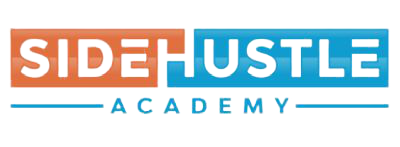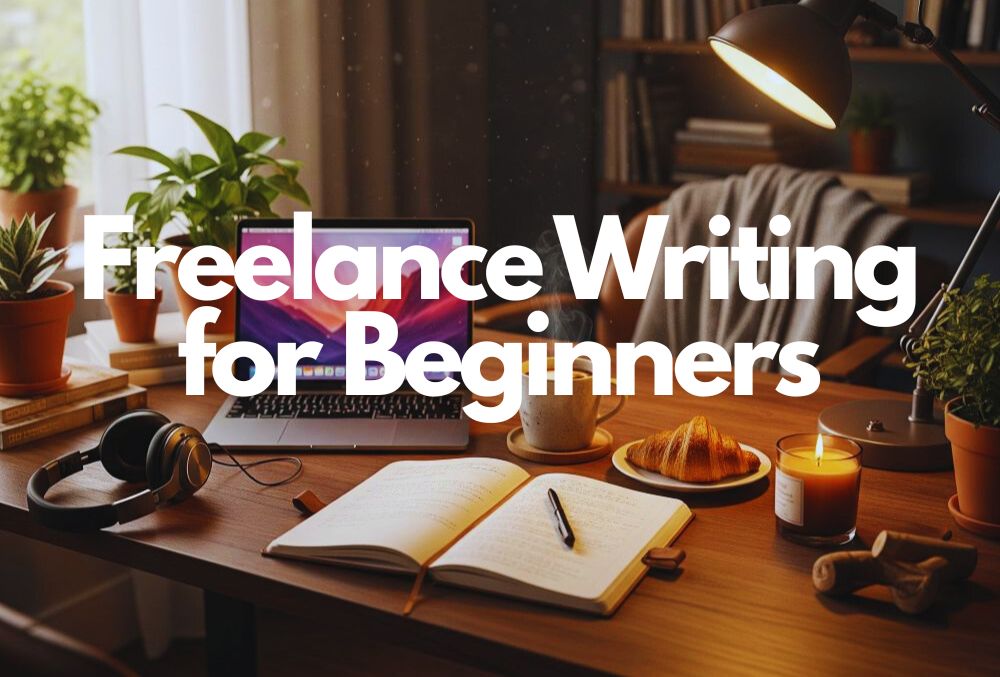Freelance Writing for Beginners: Complete Step-by-Step Guide
Over the years, I’ve taken on a few freelance writing gigs, and while I haven’t made quit-your-job money with this side hustle, I have written a significant amount of content since I started my first blog 17 years ago. So what does it take to start freelance writing for beginners?
To start freelance writing as a beginner, first choose a topic you know something about (like your work experience or hobbies), then create 2-3 sample articles to showcase your writing skills. Next, set up a simple portfolio on a free platform like Medium or LinkedIn, and start applying to entry-level writing jobs on sites like Upwork, Fiverr, or ProBlogger while gradually building your client base.
It is expected that the global freelance platforms market will grow from $5.58 billion to $14.38 billion between 2025 and 2030. So if you would like to get your piece of this pie and learn how to become a freelance writer, keep reading.
Step 1: Understanding What Freelance Writing Really Is (And What It Isn’t)
Let’s start with the basics. What is freelance writing, and how do I get started as a beginner? Simply put, freelance writing is providing writing services to clients on a project or contract basis, rather than being employed full-time by one company. You’re essentially running your own little writing business.
But here’s where many beginners get it wrong – freelance writing isn’t just about creativity and artistic expression. Sure, that’s part of it, but most freelance writing jobs are about solving business problems through words. Whether it’s helping a company explain their product better, creating content that attracts customers, or writing emails that actually get people to take action.
Once you shift your mindset from “I’m a creative writer” to “I’m a business partner who communicates through writing,” everything changes.
Think of yourself as a problem-solver who happens to use words as tools. That blog post you’re writing? It’s helping a business attract more customers. That email newsletter? It’s building relationships and driving sales.
Types of Writing Jobs Perfect for Beginners
The beauty of freelance content writing is its diversity. You don’t have to be the next Hemingway to succeed. Here are some beginner-friendly options:
Blog Posts and Articles: Companies need fresh content regularly. This is often the easiest entry point because the requirements are usually clear, and you can start with topics you already know about.
Social Media Content: If you can craft an engaging Instagram caption, you can do social media writing. Businesses need help creating posts that actually get engagement.
Product Descriptions: E-commerce is booming, and every product needs a compelling description. It’s straightforward writing with clear objectives.
Email Marketing: Those promotional emails in your inbox? Someone gets paid to write them, and it could be you.
Website Copy: Every business needs website content that explains what they do and why customers should care.

Step 2: Assessing Your Skills and Building What’s Missing
Here’s a question I get all the time: “Do I need professional experience to become a freelance writer?” The short answer? No, but you do need to be realistic about where you stand and what you need to improve.
Essential Skills Every Freelance Writer Needs
Writing Fundamentals: This seems obvious, but you’d be surprised how many people skip the basics. You need solid grammar, clear sentence structure, and the ability to adapt your voice to different audiences. If you’re rusty, don’t panic – tools like Grammarly can be your best friend while you brush up.
Research Skills: Half of good writing is good research. You’ll often write about topics you’re not an expert in, so you need to know how to quickly become knowledgeable enough to write authoritatively.
Basic SEO Understanding: Most online content needs to be found by search engines. You don’t need to become an SEO wizard overnight, but understanding how to naturally incorporate keywords (like freelance writing tips or beginner freelance writer) makes you more valuable.
Communication Skills: This isn’t just about writing – it’s about managing client relationships, asking the right questions, and setting expectations clearly.
Time Management: When you’re juggling multiple clients and deadlines, organization becomes crucial.
Quick Self-Assessment
Before you dive in, take an honest look at your current abilities. Can you write clearly and concisely? Do you understand basic grammar rules? Are you comfortable researching unfamiliar topics?
If you’re feeling shaky on any of these, don’t let that stop you. I started with decent writing skills but zero business knowledge. I learned client management the hard way (spoiler alert: it involved some very awkward conversations). The key is being honest about your gaps and actively working to fill them.
Here is a great course to help you get started that I found that can help you write with more clarity and flair.

Step 3: Choosing Your Niche (Without Overthinking It)
Ah, the niche question. “How do I choose a niche as a new freelance writer?” This is where a lot of beginners get stuck in analysis paralysis, spending weeks researching the “perfect” niche instead of just starting.
Here’s my take: your niche doesn’t have to be permanent, and it doesn’t have to be revolutionary. It just needs to be something you can write about competently while you’re building experience.
The Sweet Spot Formula
The best writing niches for beginners sit at the intersection of three things:
- What you know: Your background, interests, or experience
- What pays: Areas where businesses actually spend money on content
- What you can grow into: Topics with enough depth to keep you busy long-term
For example, if you’ve worked in customer service, you already understand common business challenges. You could write about customer experience, employee training, or small business operations. If you’re a fitness enthusiast, you could focus on wellness content, supplement reviews, or workout guides.
High-Demand Niches for Beginners
Technology and SaaS: Every software company needs content explaining what they do and why it matters.
Health and Wellness: Always in demand, but be careful about medical claims – stick to general wellness, fitness, and lifestyle topics.
Personal Finance: People always want to learn about budgeting, investing, and making money.
Small Business and Entrepreneurship: Business owners need content about marketing, operations, and growth strategies.
E-commerce and Retail: Product descriptions, buying guides, and retail trends.
The key is to pick one area and stick with it long enough to build some expertise and samples. You can always expand later.
Step 4: Building Your Portfolio (Even With Zero Experience)
This is where the “but I don’t have any samples” panic usually kicks in. “How do I build a freelance writing portfolio” when no one has hired me yet? It’s the classic catch-22, but it’s easier to solve than you think.
Creating Your First Samples
Write Spec Pieces: Choose 3-5 topics in your niche and write sample articles as if they were real client projects. Make them good – these will be your calling cards.
Guest Posting: Many websites accept guest posts. Even if they don’t pay, they give you published clips and bylines.
Personal Blog: Start a simple blog (even on Medium) and publish consistently. This shows you can create content regularly and gives potential clients something to evaluate. If you want to go a step up from that, set up a WordPress blog with your own domain by clicking here.
Volunteer Writing: Local nonprofits, small businesses, or online communities often need content help. Offer to write for free in exchange for testimonials and samples.
Rewrite Existing Content: Find poorly written content in your niche and rewrite it better. You can’t publish this, but it makes great portfolio material.
Portfolio Platforms That Actually Work
Personal Website: Tools like Squarespace or WordPress make this easier than ever. Keep it simple – a few samples, your bio, and contact information.
LinkedIn: Often overlooked, but many clients find writers through LinkedIn. Make sure your profile is optimized and share your writing regularly.
Medium: Free to use and gets good SEO. Plus, you can build an audience while showcasing your work.
Contently or Journo Portfolio: These are designed specifically for writers and look professional.
Remember, your portfolio doesn’t need to be perfect from day one. Start with what you have and improve it as you go.

If you are looking to create your own portfolio website, here is a great example site you can check out here.
Step 5: Finding Your First Clients (The Real Game Begins)
Alright, this is where things get real. “How do I find my first freelance writing clients?” This step separates the dreamers from the doers, and honestly, it’s where I see most people give up.
But here’s the thing – finding clients isn’t about having some secret insider knowledge. It’s about being consistent, professional, and willing to do the work that others won’t.
The Multi-Channel Approach
Freelance Platforms: Yes, Upwork and Fiverr get a lot of hate for low pay, but they can be solid starting points. The key is positioning yourself professionally and gradually increasing your rates as you build reviews.
Job Boards: ProBlogger Jobs, Contena, and FlexJobs regularly post legitimate writing opportunities. Set up alerts for your niche keywords.
Direct Outreach: This is where the magic happens, but it’s also where most people chicken out. Find businesses in your niche that could use better content, then reach out with a helpful, specific pitch.
Networking: Join Facebook groups for freelancers and your target niche. Engage genuinely, provide value, and opportunities will start appearing.
LinkedIn Hustle: Optimize your profile, connect with potential clients, and share valuable content regularly. Many of my best long-term clients found me through LinkedIn.
Quick Tip: If you are having a tough time finding your first client, offer to write the first article for free. Then, if they like it, make an offer that can be hard for them to refuse, like writing 3 articles at a reduced rate. At the very least ask them for some feedback on your content.
The Art of the Pitch
Your first pitch is crucial. Here’s what works:
- Subject Line: Keep it specific and benefit-focused
- Opening: Reference something specific about their business
- Value Proposition: Explain exactly how you can help them
- Proof: Include a relevant sample or brief case study
- Call to Action: Make it easy for them to respond
Here is a sample letter using this simple strategy.
Hi Sarah,
I noticed that FitLife Nutrition hasn’t published new blog content in over two months, yet your competitors are posting weekly articles that are ranking well for keywords like “natural energy boosters” and “meal prep for busy professionals.”
I specialize in creating SEO-optimized health and wellness content that helps businesses like yours attract more organic traffic and convert visitors into customers. My articles typically include keyword research, engaging headlines, and clear calls-to-action that drive newsletter signups and product sales.
For example, I recently wrote a series of meal prep articles for a supplement company that increased their organic traffic by 40% in three months and generated over 200 new email subscribers. You can see a sample of my work here: [link to relevant portfolio piece].
Would you be interested in a quick 15-minute call this week to discuss how I can help FitLife Nutrition get back to consistent, traffic-driving content? I’m available Tuesday or Wednesday afternoon.
Best regards,
[Your Name]
Step 6: Setting Your Rates and Managing Finances
Let’s talk money. “How much can a beginner freelance writer expect to earn?” The answer varies wildly, but I’ll give you some realistic benchmarks and strategies.
Pricing Strategies for Beginners
Starting Rates: For beginners in the US market, expect to start somewhere between $0.03-$0.10 per word for basic content, or $25-$50 per hour for project work. Yes, it feels low, but you’re buying experience.
Progressive Pricing: Plan to increase your rates every 3-6 months as you gain experience and better samples. The goal is to reach $0.15-$0.25 per word or $50-$75 per hour within your first year.
Value-Based Pricing: As you get more experienced, shift from hourly to project-based pricing. Focus on the value you’re providing rather than the time spent.
Rate Comparison Table
| Experience Level | Per Word | Per Hour | Per Project |
|---|---|---|---|
| Complete Beginner | $0.03-$0.05 | $15-$25 | $50-$150 |
| Some Experience (3-6 months) | $0.05-$0.10 | $25-$40 | $150-$300 |
| Intermediate (6-12 months) | $0.10-$0.20 | $40-$65 | $300-$800 |
| Experienced (1+ years) | $0.20-$0.50+ | $65-$100+ | $800-$2000+ |
Managing Your Freelance Finances
Separate Business Account: Keep your freelance income separate from personal expenses. It makes taxes much easier. I prefer PayPal because it’s free and you can send invoices with it.
Invoice Promptly: Use tools like Wave, FreshBooks, or PayPal to create professional invoices and track payments. In the beginning, just keep it simple and low budget. There is no need to spend a lot of money until you are a little further down the road.
Save for Taxes: Set aside 25-30% of your income for taxes. Quarterly payments are usually required. I recommend talking to your accountant once you get over $600 in earnings.
Emergency Fund: Freelance income can be unpredictable. Aim for 3-6 months of expenses saved.
Step 7: Avoiding Common Beginner Mistakes
I’ve made every mistake in the book, so let me save you some pain. Here are the biggest traps new freelance writers fall into:
Pricing and Business Mistakes
Working for Peanuts: Yes, you’ll start low, but don’t stay there. I once wrote a 2,000-word article for $25 because I was desperate. Learn from my pain.
No Contracts: Always, always use a contract. Even a simple one-page agreement protects both you and your client. Here is a basic contract I put together to help you get started.
Scope Creep: When clients ask for “just one small change” that turns into a complete rewrite, you need boundaries.
Not Following Up: Many potential clients don’t respond to first pitches. Following up professionally can double your response rate.
Quality and Professionalism Issues
Over-Promising: Don’t promise to deliver in 24 hours if you need 48. Under-promise and over-deliver.
Ignoring Guidelines: If a client asks for specific formatting or style, follow it exactly. This seems obvious, but you’d be surprised.
Poor Communication: Respond to messages promptly and professionally. Communication issues kill more freelance relationships than bad writing.
Avoiding Scams and Low-Paying Gigs
Red Flags: Be wary of clients who ask for free samples, offer payment only after publication, or promise exposure instead of money.
Research Clients: Check their website, social media, and online presence. Legitimate businesses have legitimate online footprints.
Trust Your Gut: If something feels off, it probably is. There are plenty of legitimate clients out there.
Step 8: Scaling Your Freelance Writing Business
Once you’ve got your first few clients and some money coming in, it’s time to think bigger. The goal isn’t just to stay busy – it’s to build a sustainable business that gives you the freedom you’re looking for.
Building Long-Term Client Relationships
The secret to freelance success isn’t constantly hunting for new clients – it’s turning one-time projects into ongoing relationships. Here’s how:
Exceed Expectations: Deliver better quality than promised, ahead of deadline when possible.
Proactive Communication: Don’t just complete assignments – suggest improvements and new opportunities.
Understand Their Business: The more you understand your client’s goals, the more valuable you become.
Consistent Quality: Every piece you deliver should meet the same high standard.
Expanding Your Services
As you get comfortable with basic writing, consider adding complementary services:
Content Strategy: Help clients plan their content calendar and messaging.
SEO Optimization: Learn more advanced SEO techniques to make your writing more valuable.
Social Media Management: Many clients need help beyond just writing content.
Email Marketing: Newsletter writing and email sequence creation are high-value skills.
Building Passive Income Streams
Digital Products: Create writing templates, courses, or guides for other beginners.
Affiliate Marketing: Recommend tools and services you actually use (like the ones in our tools section).
Recurring Clients: Focus on landing clients who need regular content (weekly blog posts, monthly newsletters, etc.).
Essential Tools for Freelance Writing Success
Having the right tools can make the difference between struggling and thriving. Here are the essentials every beginner freelance writer needs:
Writing and Editing Tools
Grammarly: Your grammar and style safety net. The premium version is worth the investment.
Google Docs: Free, collaborative, and accessible anywhere. Perfect for client work.
Hemingway Editor: Helps you write more clearly and concisely.
Organization and Productivity
Trello: Organize your projects, deadlines, and client communications.
Toggl: Track your time to understand your true hourly rate and improve efficiency.
Calendly: Let clients schedule calls without the back-and-forth email dance.
Business Management
Wave: Free invoicing and expense tracking for small businesses.
DocuSign: Professional contract signing made easy.
LastPass: Secure password management for all your accounts.
Research and SEO
Google Keyword Planner: Free keyword research for SEO-focused content.
BuzzSumo: See what content performs well in any niche.
Answer The Public: Discover what questions people are asking about your topics.
The Road Ahead: Your Freelance Writing Journey
Starting your freelance writing career can feel overwhelming – trust me, I remember staring at my computer screen, wondering if I was crazy for thinking I could make this work. But here’s what I wish someone had told me back then: you don’t need to have everything figured out before you start.
The freelance writing world is constantly evolving. What worked five years ago might not work today, and what works today might be outdated in two years. The key is staying adaptable, continuing to learn, and always focusing on providing real value to your clients.
Setting Realistic Expectations
Month 1-2: Focus on building your portfolio and landing your first paid project. Don’t expect to replace your day job income yet.
Month 3-6: Start building recurring client relationships and gradually raise your rates. You might make $500-$2000 per month.
Month 6-12: With consistent effort, many writers reach $2000-$5000 monthly. Some hit it faster, others take longer.
Year 2+: The sky’s the limit. I know writers making $10K+ monthly, but it requires treating this as a serious business.
Building Your Support Network
This journey doesn’t have to be lonely. Connect with other freelance writers through:
Online Communities: Join Facebook groups, Reddit communities, and Discord servers for freelancers.
Local Meetups: Many cities have freelancer meetups or coworking spaces.
Professional Organizations: Consider joining groups like the American Writers & Artists Inc. (AWAI) or Freelancers Union.
Mentorship: Find experienced writers willing to share advice. Many are surprisingly generous with their knowledge.
Your Next Steps
Ready to dive in? Here’s your action plan for the next 30 days:
Week 1:
- Choose your niche
- Set up a simple portfolio website
- Write your first 2-3 sample pieces
Week 2:
- Create profiles on 2-3 freelance platforms
- Join relevant Facebook groups and online communities
- Research 10 potential clients in your niche
Week 3:
- Send your first 5 pitches
- Continue creating content for your portfolio
- Set up your basic business systems (invoicing, contracts)
Week 4:
- Follow up on pitches
- Send 5 more pitches
- Evaluate what’s working and adjust your approach
Remember, freelance writing for beginners is a marathon, not a sprint. Some weeks will be discouraging. Others will have you feeling like you’re on top of the world. Both are normal.
The writers who succeed aren’t necessarily the most talented – they’re the ones who stick with it, keep improving, and treat their freelance career like the business it is.
So, what are you waiting for? That first pitch won’t write itself. Your future clients are out there right now, looking for someone exactly like you to help them tell their story better.
The only question left is: are you ready to become the writer you’ve always wanted to be?
Ready to start your freelance writing journey? Bookmark this guide and take the first step today. Remember, every successful freelance writer started exactly where you are right now – with a desire to write and the courage to begin.








